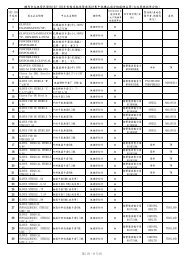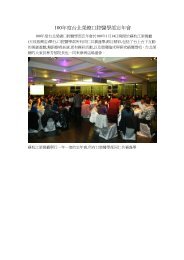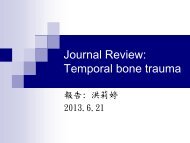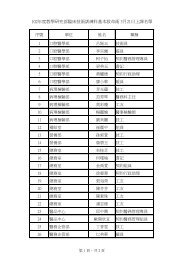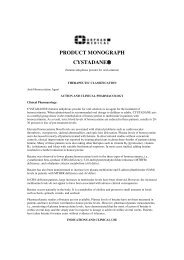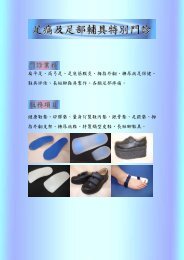㆒般外科常見疾病(㆒) - 臺北榮民總醫院
㆒般外科常見疾病(㆒) - 臺北榮民總醫院
㆒般外科常見疾病(㆒) - 臺北榮民總醫院
Create successful ePaper yourself
Turn your PDF publications into a flip-book with our unique Google optimized e-Paper software.
<strong><strong>㆒</strong>般外科常見疾病</strong>(<strong>㆒</strong>)<br />
國立陽明大㈻ ㊩㈻系外科<br />
台北榮民總㊩院 <strong>㆒</strong>般外科<br />
龍藉泉
Acute Appendicitis<br />
Most common surgical acute<br />
abdomen<br />
Incidence : 20~30 y/o most common
Etiology of Acute Appendicitis<br />
Obstruction - due to fecalith<br />
Hypertrophy of lymphoid tissue<br />
Inspissated barium<br />
Vegetable and fruit seeds<br />
Intestinal worms - ascarids
Symptoms of Acute Appendicitis<br />
Shifting abdominal pain<br />
Nausea, Vomiting<br />
Diarrhea
Shifting Abdominal Pain
Nausea, Vomiting, Why?
Signs of Acute Appendicitis<br />
Mcburney’s point tenderness<br />
Rebounding pain and muscle<br />
rigidity.<br />
Rovsing’s sign<br />
Psoas sign<br />
Obturator’s sign
Mcburney’s point tenderness
Obturator’s Sign
Psoas’s Sign
Treatment of Acute Appendicitis<br />
• Open appendectomy<br />
• Laparoscopic appendectomy<br />
• Partial cecotomy<br />
• Right hemicolectomy<br />
• Pig-tail drainage<br />
• Surgical drainage<br />
• Antibiotics
Hernia<br />
• ( a Latin term, that means rupture of a<br />
proportion of a structure )
Etiology of Hernia<br />
• Anatomical factors<br />
• Congenital factors<br />
• Biological factors<br />
– Malnutrition<br />
– Environmental toxins<br />
– Athletics<br />
– Iatrogenic factors
• History<br />
Diagnosis of Hernias<br />
• Physical Examination - most important<br />
• Radiological findings -<br />
Chest PA, KUB, Herniography,<br />
Ultrasonography, CT
Incarcerated?<br />
Strangulated?<br />
Sliding?
Groin Hernia<br />
• Indirect inguinal hernia - the most<br />
prevalent type of hernia in the infant,<br />
children, and adult.<br />
• Femoral hernia - more common in<br />
the adult female
Anterior view of inguinal region
Posterior view of Inguinal Region
Indication for Hernioplasty<br />
• All hernias should be repaired unless<br />
local or systemic condition is not<br />
permitted.<br />
• Trusses and surgical belt are helped in<br />
the management of small hernias unless<br />
operation is contraindicated.<br />
• Trusses are contraindicated for<br />
patients with femoral hernia.
Treatments of Hernia<br />
• Truss<br />
• Hernioplasty<br />
Anterior approach<br />
posterior approach<br />
Prosthesis
Complications of Inguinal<br />
Hernioplasty<br />
• Ischemic orchitis<br />
• Testicular atrophy<br />
• Neuralgia<br />
• Recurrence
Hernia Truss
Small Intestine<br />
• Accounts for 70% to 80% of the<br />
length of the gastrointestinal tract
Indication of the Surgery<br />
• Bleeding<br />
• Obstruction<br />
• Perforation<br />
• Malignancy<br />
for Intestine
Diseases of the Intestine<br />
• Inflammatory disease<br />
• Neoplasm<br />
• Diverticular disease<br />
• Vascular disease<br />
• Intestinal obstruction<br />
• Miscellaneous
Meckel’s Diverticulum<br />
• Incomplete closure of<br />
omphalomesenteric duct (vitelline duct)<br />
• Locating on the terminal ileum, 50 to<br />
70 cm proximal to the ileocecal valve.<br />
• Heterotopic gastric or pancreatic<br />
tissues is often found.
Meckel’s Diverticulum
Meckel’s Diverticulum
Intestinal Obstruction (1)<br />
Mechanical obstruction of the lumen<br />
• Obturation of the lumen – Meconium,<br />
Intussusception, Gall stones, Impaction<br />
• Lesions of bowel – Congenital, Traumatic,<br />
Inflammatory, Neoplastic, miscellaneous<br />
• Lesions extrinsic to the bowel – Adhesive<br />
band, Hernia, wound dehiscence, Extrinsic<br />
masses<br />
• Vovulus
Intestinal Obstruction (2)<br />
Inadequate propulsive motility<br />
• Neuromuscular defects – Megacolon,<br />
Paralytic ileus, Spastic ileus<br />
• Vascular Occlusion
Vascular disease of the Intestine<br />
• Mesenteric vascular disease<br />
• Submucosal vascular anomaly
Mesenteric vascular disease<br />
• Arterial<br />
• Acute<br />
• Occlusive<br />
of the Intestine<br />
• Venous<br />
• Chronic<br />
• Nonocclusive
Blind Loop Syndrome<br />
• Bacterial overgrowth in stagnant areas of small<br />
intestine.<br />
• Bacteria compete for Vit.B12, Vit.B12 absorption<br />
decrease, megaloblastic anemia may appeared.<br />
• Schilling test ( 60 Co-labeled B12 absorption) with or<br />
without administration of tetracycline is the<br />
diagnostic method.<br />
• Surgical correction of stagnation is indicated and<br />
effective.
Short Bowel Syndrome<br />
• If terminal ileum and ileocecal valve<br />
present, resection up to 70% is tolerated.<br />
• Proximal bowel resection is tolerated<br />
better than the distal resection.<br />
• Nutritional support is the main treatment.<br />
• Surgical operation is still under debate



